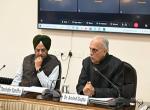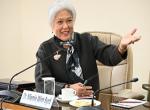The Vivekananda International Foundation (VIF) hosted a delegation from the International Department of the Central Committee of the Communist Party of China (IDCPC), led by Ms Huang Yihua, the Deputy Director General of Research Office of the IDCPC and comprised of Ms Wang Xiaoying, Mr Wu Hang and Mr Yan Runqing. Dr Arvind Gupta, Director VIF, delivered the opening remarks and presided over the session.
Discussion were held on the concept of the Indo-Pacific; the difference between the United States Strategy and India’s Indo-Pacific Region and the recent 2+2 Dialogue between India and the US.
India’s Vision of the Indo-Pacific
The Indian participants expounded on the concept of Indo-Pacific. The best description of India’s approach to the Indo-Pacific is the speech delivered by the Indian Prime Minister Narendra Modi at the Shangri La Dialogue 2018 in Singapore. In the speech, he highlighted six basic principles of the concept: The Indo-Pacific region spreads from the West Pacific to the America’s; it is essentially an inclusive idea that gives primacy to the centrality of the Association of Southeast Asian Nation (ASEAN); India stands for a rule-based order in the region; in practical terms, India stands for freedom of navigation, uninterrupted commerce, and peaceful settlement of disputes; India does not subscribe to any rivalries in the region; and India’s relationships with other countries are not alliances. Against this background, the Quadrilateral between India, Japan Australia and the US is very similar to the other forums like the Russia, India and China (RIC) or the India, US and Japan trilateral. Thus the QUAD is not directed towards any other Country.
The Indian delegates emphasised that India’s Trade with the region is growing rapidly. India’s investments flow through the Indo-Pacific region. Hence our relations with the countries in the region are becoming stronger. Essentially, India wants to improve the collective security in the region for which it is using various the forum in the region. India is a member of the ASEAN Defence Minister Meeting Plus (ADMM), the Bay of Bengal Initiative for Multi-Sectoral Technical and Economic Cooperation (BIMSTEC), Mekong Ganga Cooperation (MGC), Economic Corridor, and Forum for India-Pacific Islands Cooperation (FIPIC). The Security and Growth for All in the Region (SAGAR) envisioned by the PM Narendra Modi in 2015, applies to the entire Indo-Pacific Region as well. At present it is difficult to separate the security of the Indian Ocean from any other Ocean. Hence the concept of the Indo-Pacific is gaining traction. Perhaps China has also realised this while participating in the anti-piracy operations.
The Indian delegates clearly highlighted the difference between the concepts of the Indo-Pacific Strategy with that of the Indian vision of the Indo-Pacific Region. For the US the Indo-Pacific Strategy has evolved from the US ‘pivot to Asia’. The US is paying more attention to its own security. The change in the command structure of the USPACOM to US Indo-Pacific Command is indicative of their agenda in the Indo-Pacific region. On the other hand, India’s concept of the Indo-Pacific stands for the centrality of ASEAN, bilateral security of all countries in the region and not directed towards any one country.
2+2 Dialogue
The 2+2 Dialogue is a gradual progression of the India-US relations. In this globalised world, India looking for friendship with major countries - China, the US and Russia. The 2+2 Dialogue is a need-based agreement on the national interest of India. It is in consonance with the flagship initiative of ‘Make in India’. India is looking at interoperability and at this juncture the global commons become important. A major part of the 2+2 Dialogue joint statement is devoted to the concept of Indo-Pacific. It further gives importance on the infrastructure development, no country should enter into the debt trap. It also stresses on securing Afghanistan, greater prosperity and people to people contact.
Points of Discussion
- The Chinese delegates expressed their concern about Japan’s proposal of not starting any new mechanism in the Indo-Pacific region. The Indian delegates argued that there are already a number of mechanism such as Indian Ocean Rim Association (IORA), Indian Ocean Naval Symposium (IONS), ASEAN Defence Minister Meeting (ADMM) plus, ASEAN Regional Forum (ARF), Asia-Pacific Economic Cooperation (APEC), QUAD in the region. The emergence of any other mechanism depends on the evolving geo-politics of the region.
- The Indo-Pacific concept is evolving. The last statement released by all the four countries illustrates that there is a convergence of interest of all the countries in the region.
- The Chinese delegates articulated their apprehension on the pledge of USD 300 million by the US for Southeast Asia and USD 113 million in technology, energy and infrastructure initiatives in emerging Asia. The Indian side elucidated that the US has sanctioned the amount to express its economic involvement in the region. However, the amount sanctioned is not much. Also, the funds are supposed to be managed by the Public Private Partnership model.
- The Chinese delegates opined that any proposal in the region should be in line with the global trend.
In the conclusion, the Chinese delegates reiterated that China stands for regional cooperation in the Indo-Pacific region and they are on the same page with India on this issue.








Post new comment